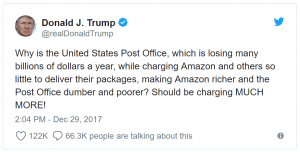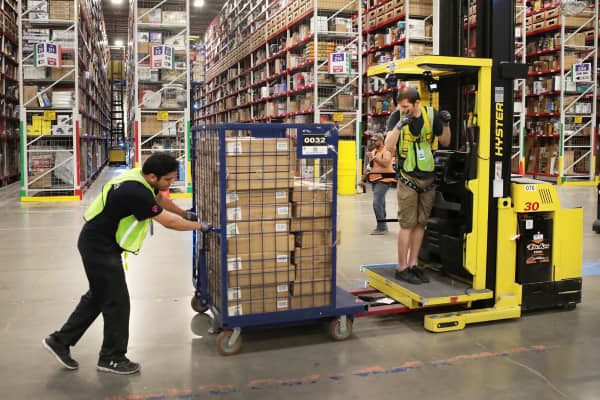
Cargo aircrafts from UPS, FedEx and DHL are parked at Cargo City at Arlanda airport in Stockholm.
- Amazon’s entry into delivery service won’t be as bad for UPS and FedEx as it will be for the USPS, Amazon’s largest carrier, says J.P. Morgan.
- Shares of UPS and FedEx have underperformed the market since news broke of Shipping with Amazon broke last Friday.
Amazon’s reported entry to delivery service won’t be as bad for UPS and FedEx as it will be for the United States Postal Service, according to a J.P. Morgan analyst in the space.
“Sentiment remains cautious on the two stocks based on a heightened risk of disruption. We believe the headline overlooks the primary company at risk, which is the U.S. Postal Service,” wrote analyst Brian Ossenbeck. “We estimate the USPS is Amazon’s largest carrier so not only does it stand to lose volumes from Shipping with Amazon, but it generally lacks the same labor flexibility and service offerings; postal workers are unionized and Amazon Flex drivers can also provide premium products and services such as perishable goods and same day deliveries.”
Ossenbeck’s note came one week after the Wall Street Journal reported that the e-commerce giant is gearing up to launch its own delivery service – called Shipping with Amazon (SWA) – a move many deem a jab at carriers UPS and FedEx.
Since the news broke last Friday, shares of both companies have underperformed the broader market: UPS and FedEx are up 0.3 percent and 4 percent respectively versus the S&P 500’s 4.4 percent rebound.
UPS fell nearly 1 percent Friday, while FedEx slipped 0.34 percent to $244.19. The analyst likes FedEx the most of the two with an overweight rating and a price target of $315 on the shipper. He is neutral on UPS and his 12-month price forecast is $139.
“With a localized pick-up and delivery system beginning within the Amazon ecosystem, the service is not directly comparable to the standard ground offerings of either public carrier but rather the final mile of the USPS,” Ossenbeck added. “While UPS and FedEx could face pressure if the capabilities expand into business-to-business or international deliveries, we expect the lost volumes to SWA or the FBA Onsite optimization will actually provide some relief to the significant mix pressure from an accelerating pace of business-to-consumer volume growth.”
Amazon started taking most of its packages directly to the Postal Service in 2013, a way of avoiding the expensive last leg of the delivery in high-density metro areas.

However, pundits argue that USPS is underselling its services, with e-commerce giants taking advantage of the universal service obligation that the USPS must maintain by law.
With reports from CNBC
.










